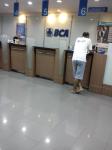Satu lagi kenyataan pahit harus aku hadapi. Orang yang cukup dekat denganku membuat keputusan yang salah, sangat salah. Adik bosku ini adalah mahasiswa tingkat akhir di sebuah universitas swasta ternama di Surabaya. Umurnya tak jauh berbeda denganku. Namun pola pikirnya sudah sedemikian dirasuki oleh ketergantungan sistem operasi berbasis DOS yang bernama Windows 7 dan produk Microsoft lain.
Bukan maksudku ingin menyudutkan, mengejek, atau menghina pengguna sistem operasi Windows 7. Aku sendiri adalah pengguna sistem operasi milik Microsoft Corporation ini. Hanya saja, aku hanya menggunakan Windows saat ingin memainkan game-game terbaru seperti Assassin’s Creed, Need For Speed, Batman : Arkham City, dan lain-lain. Selain untuk memainkan game, aku hanya membuka Windows secara berkala untuk mengupdate Anti-Malware (Kaspersky Internet Security 2011, lisensi legal) dan mengupdate Windows serta untuk melakukan defragmentasi pada HDD (hard disk drive).
Di luar itu semua, aku hanya menggunakan Linux (Ubuntu) sebagai sistem operasi utama. Mengapa? Ini dikarenakan sifat Linux sendiri yang unggul dari segi keamanan, kehandalan, dan kestabilan sistem serta bebas dari masalah fragmentasi.
Kembali ke topik awal. Temanku ini sama sekali tidak peduli bila sistem operasi yang dipakainya adalah hasil dari aktifitas pembajakan. Bahkan saat kutunjukkan notebook milikku yang memiliki bukti keeaslian dan kelegalan sistem operasi Windows ia malah menantang balik. Ia menanyaiku dengan pertanyaan tentang pembuktian kepalsuan lisensi Windows miliknya. Yang ia tahu hanyalah menggunakan Windows dan Microsoft Office tanpa peduli lisensinya legal atau tidak.
Sungguh, hal ini membuatku sangat sedih. Betapa seorang Kristen seperti dia (dan banyak orang-orang lain di luar sana) yang memilih untuk menjual Tuhan demi sebuah lisensi sistem operasi Windows 7 palsu yang cukup tangguh karena Windows miliknya bisa diupdate tanpa mengalami hilangnya wallpaper maupun blue screen of death.
Mungkin aku terlihat mengggabungkan dua isu berbeda (masalah open source dan Kekristenan), tapi lihatlah konteksnya secara utuh. Bukankah kita harus berusaha untuk selalu melakukan Firman Tuhan kapanpun dan di manapun dalam tiap aspek dan segi kehidupan? Dan menggunakan FOSS (Free and Open Source Software, Perangkat Lunak Bebas dan Kode Sumber Terbuka) adalah salah satu perwujudan dan pelaksanaan dari Firman Tuhan? Kesepuluh Firman dengan jelas melarang kita untuk mencuri. Apakah perbedaan dari membajak sistem operasi (dan perangkat lunak lain) dengan mencuri? Pembajakan mencuri keuntungan dari lisensi yang seharusnya dibeli oleh pengguna dan mencuri hak kekayaan intelektual yang dimiliki pemilik dan pengembang perangkat lunak.
Bila memang ingin menggunakan perangkat lunak itu, mengapa tidak ingin membayar lisensi untuk menggunakannya? Bila memang ingin makan nasi, mengapa tidak memasak atau membelinya? Selalu ada harga yang harus dibayar untuk bisa menikmati sesuatu, termasuk perangkat lunak (FOSS sekalipun). Dan bila memang tidak ingin membayar lisensi, mengapa tidak menggunakan perangkat lunak berbasis dan berlisensi FOSS? Ribuan distribusi (sistem operasi) berbasis Linux yang gratis dan berkualitas ada di luar sana. Bahkan perangkat lunak yang disediakan sebagai pengganti perangkat lunak yang sering kita gunakan pun tersedia. Bahkan seringkali lebih baik dan berkualitas dari yang berbayar.
Namun perlu digarisbawahi, tidak semua perangkat lunak berbasis open source adalah perangkat lunak yang gratis (dari segi biaya). Namun perangkat lunak itu selalu bebas untuk digandakan, dimodifikasi, dan digunakan oleh siapa saja. Info lebih lanjut silakan buka :
http://gnu.org yaitu sebuah situs yang berisi info lengkap mengenai lisensi GNU General Public License, lisensi yang sering digunakan pada perangkat lunak FOSS.
Menggunakan perangkat lunak baru memang tidak mudah, apalagi untuk mempelajarinya dari awal. Namun jauh lebih baik daripada harus membajak perangkat lunak. Apalagi selalu ada internet dan komunitas untuk membantu pemecahan masalah. Lebih lanjut silakan mengunjungi :
http://linux.or.id yaitu sebuah laman internet yang dikelola oleh komunitas pengguna Linux Indonesia yang memberi gambaran sekilas tentang apa itu Linux. Memang tidak semua FOSS adalah Linux, namun komunitas pengguna Linux yang sudah cukup besar di Indonesia membuat Linux sebagai contoh ideal untuk FOSS.
Tantangan berat sedang dihadapi oleh Komunitas Pengguna Linux Indonesia. Disaat masyarakat masih buta dengan apa itu lisensi, KPLI malah harus sudah masuk ke tahap berikutnya, mengenalkan FOSS ke publik Indonesia, dan pada akhirnya, meng-FOSS-kan Indonesia.
Pada intinya, untuk membuat FOSS berjaya di Indonesia, kita harus mengurangi ketergantungan pada perangkat lunak dengan kode sumber tertutup dan menggantinya dengan perangkat lunak dengan kode sumber terbuka dengan lisensi FOSS (yang biasa digunakan adalah lisensi GNU General Public License). Kemudian secara perlahan memigrasikan Indonesia ke perangkat lunak FOSS.
Masih ada yang memakai perangkat lunak berkode sumber tertutup (mis. Windows, Mac OSX, Adobe Photoshop, dll)? Selama lisensi yang digunakan adalah lisensi legal tanpa membajak, kita tidak bisa melarang mereka. Itu hak mereka dan hak kalian untuk menggunakan perangkat lunak yang dibutuhkan, asalkan, lisensi yang digunakan adalah lisensi legal.
Pada intinya adalah, selama kalian bisa membeli lisensi perangkat lunak itu secara legal tanpa membajak, silakan saja. Namun bila memang tidak bisa, tidak mau, atau tidak mampu membeli lisensi legal, mengapa tidak mencoba memakai perangkat lunak FOSS yang jelas-jelas adalah perangkat lunak yang gratis untuk dipakai (freeware) dan dimodifikasi dan disebarkan (open source-ware).
Akhir kata, cobalah membuka pandangan dan melihat segala kemungkinan lain yang mungkin tidak terbayangkan sebelumya. Bisa jadi kemungkinan yang terlewat itu adalah kemungkinan yang lebih baik dibandingkan apa yang dimiliki sekarang.










